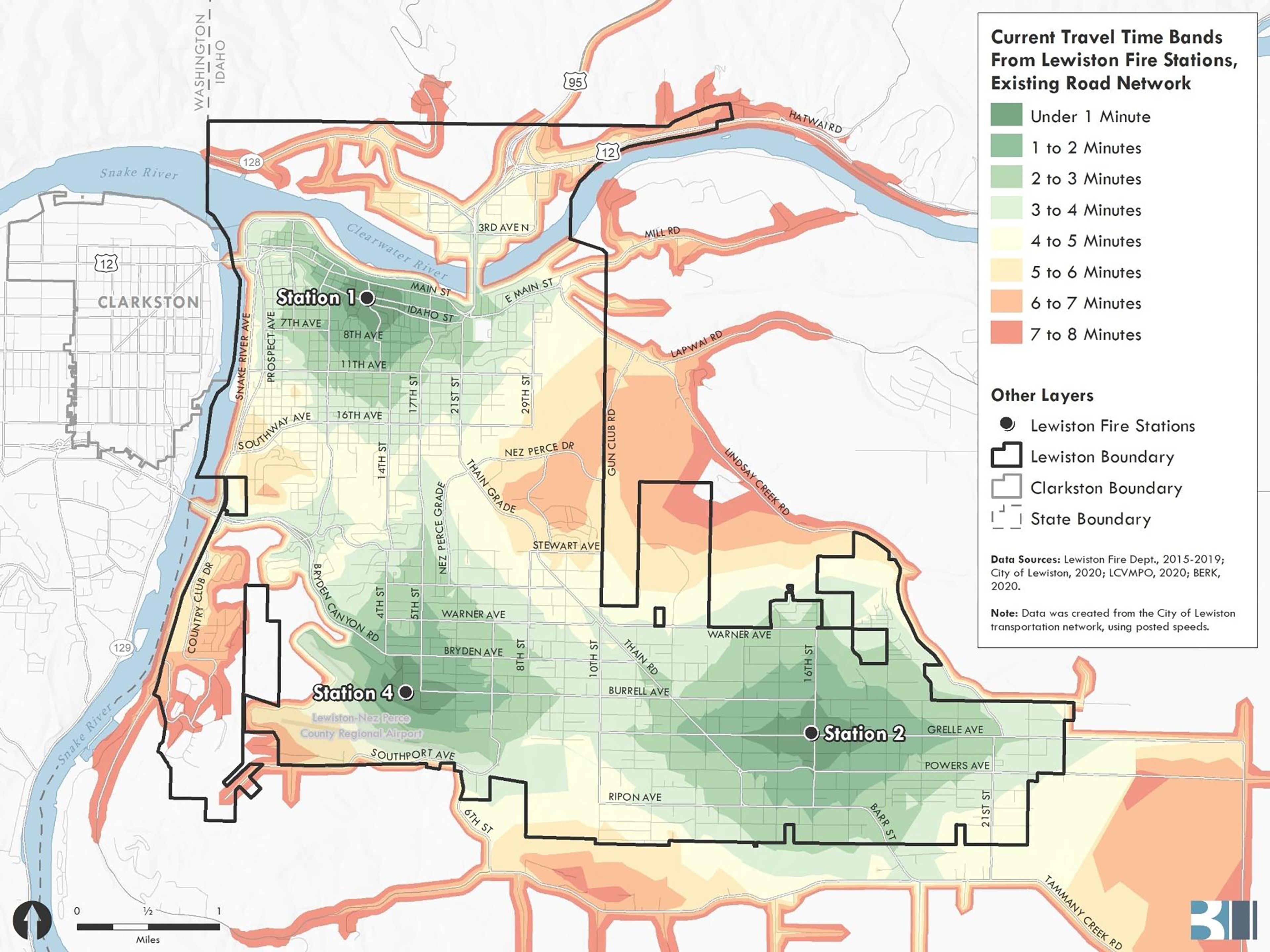Many dwellings in the Elks Addition are among the Lewiston homes that are more than a five-minute drive from a fire station.
That information comes from a color-coded map that’s helping Lewiston’s elected officials decide what upgrades might be needed to get firefighters and paramedics on the scenes of emergencies in an even more timely manner.
Almost all of Lewiston is shown in shades of green, indicating those neighborhoods can be reached within four minutes or less by vehicles, according to the map in a station study that was recently part of a presentation by Lewiston Fire Chief Gregory Rightmier to the Lewiston City Council.
But some areas are in yellow or several hues of orange, showing they are between four and eight minutes from Lewiston’s three fire stations, at 300 13th St. in downtown, 1533 Grelle St. in the Orchards and on Burrell Avenue, next to the Lewiston-Nez Perce County Regional Airport, also in the Orchards.
Besides parts of the Elks Addition, a southern section of Normal Hill, a portion of the Reno Addition and a neighborhood near North 40 Outfitters are among the areas in orange.
The council is in the early stages of studying options to improve response times after deciding last year not to construct a proposed fire station at Fifth Street and Bryden Avenue, when the price tag ballooned to more than $7.7 million.
That station would have replaced the one near the airport.
While a difference of four minutes or less may not seem like much, it can be significant if a home is on fire or if someone isn’t breathing, Rightmier said.
The industry standard of the National Fire Protection Association is to have 16 firefighters on the scene in eight minutes 90% of the time if a two-story, 2,000-square-foot home is on fire, he said.
The eight minutes is rooted in what is known about how long it takes for a home to reach a stage called “flashover,” developed with information about building materials, what furniture is made of and chemicals often found at homes, Rightmier said.
“(It’s) a technical term to basically mean the entire inside of the building ignites,” he said. “Enough of the material in the house has been preheated, and it’s off-gassing, and then it all catches fire at once.”
When that happens, people can’t survive, Rightmier said.
“Instantly the temperature goes from 200 or 300 degrees to being 1,200 degrees,” he said. “We can’t really survive that in our protective gear for more than about 30 seconds.”
On the medical side, the American Heart Association has found that four to six minutes after someone stops breathing is when irrevocable brain damage begins, he said.
The driving times are one of three pieces of response times. The other two are dispatch and crew mobilization.
Typically, dispatchers gather information about the location and nature of an emergency and relay that to police, firefighters and paramedics in about 90 seconds, Rightmier said.
Once emergency responders are alerted, it takes about 80 seconds to don gear and climb aboard ambulances or fire trucks, with those tasks typically taking longer at night when personnel are asleep, he said.
Other factors affect response times too.
While emergency crews running sirens, for example, may exceed the speed limit by perhaps 10 mph if they’re on the highway, typically the way they drive is very similar to other motorists, stopping at traffic lights and following reduced speeds in school zones, he said.
Additionally, the overall call volume in Lewiston is growing, increasing the chances of the still-rare situation when an emergency surfaces when all of the crews on duty are already deployed, Rightmier said.
Exactly what strategy the city pursues will be determined by its elected officials, Rightmier said.
The 90 seconds it takes to dispatch calls could be reduced with an upgrade in technology that might cost in the neighborhood of $300,000 to $500,000, significantly less than a new fire station, he said.
A proposal to purchase that upgrade is something that he plans to bring before the council in the coming months, Rightmier said.
It has an additional advantage of awakening crews with noises that are less startling than what’s used now and in the long term helps reduce cardiac issues for firefighters and paramedics, he said.
Beyond that, one of the few other approaches will likely involve moving the locations of Lewiston’s downtown fire station and its fire station near the Lewiston-Nez Perce County Regional Airport, which will be City Council decisions, Rightmier said.
“That’s geography,” he said. “Given the constraints of the roads that we have right now, that’s the best solution to look at.”
Williams may be contacted at ewilliam@lmtribune.com or (208) 848-2261.









